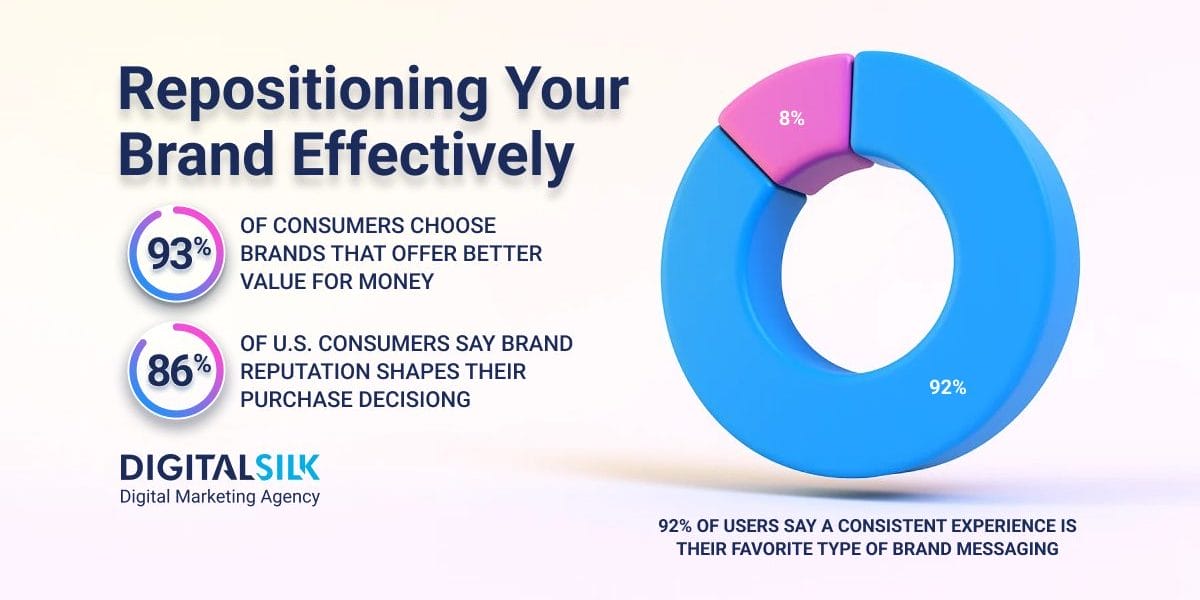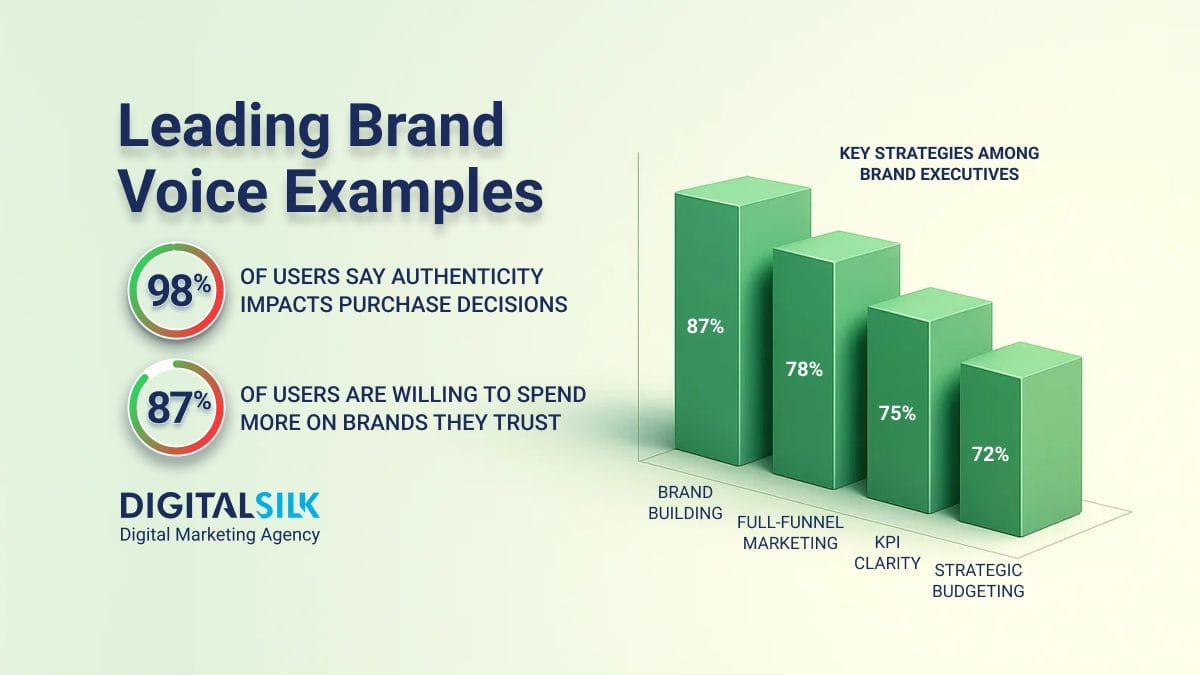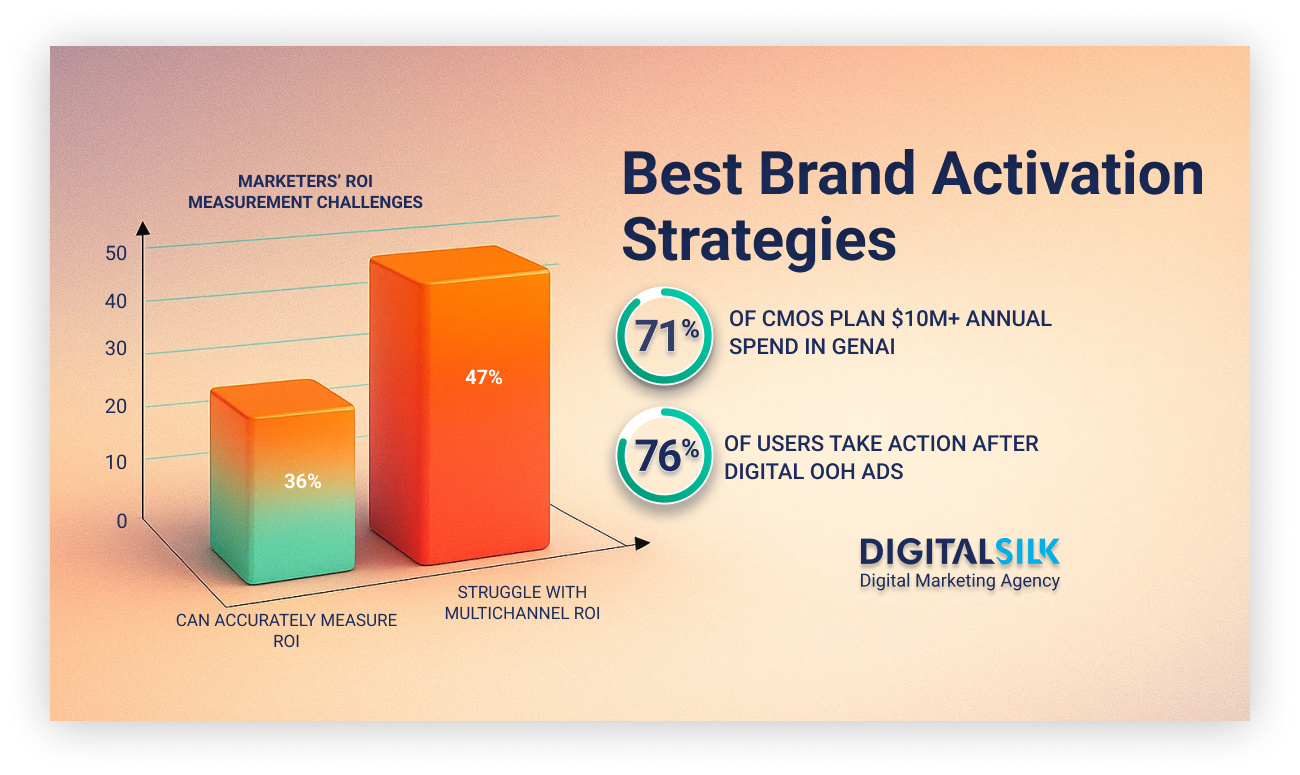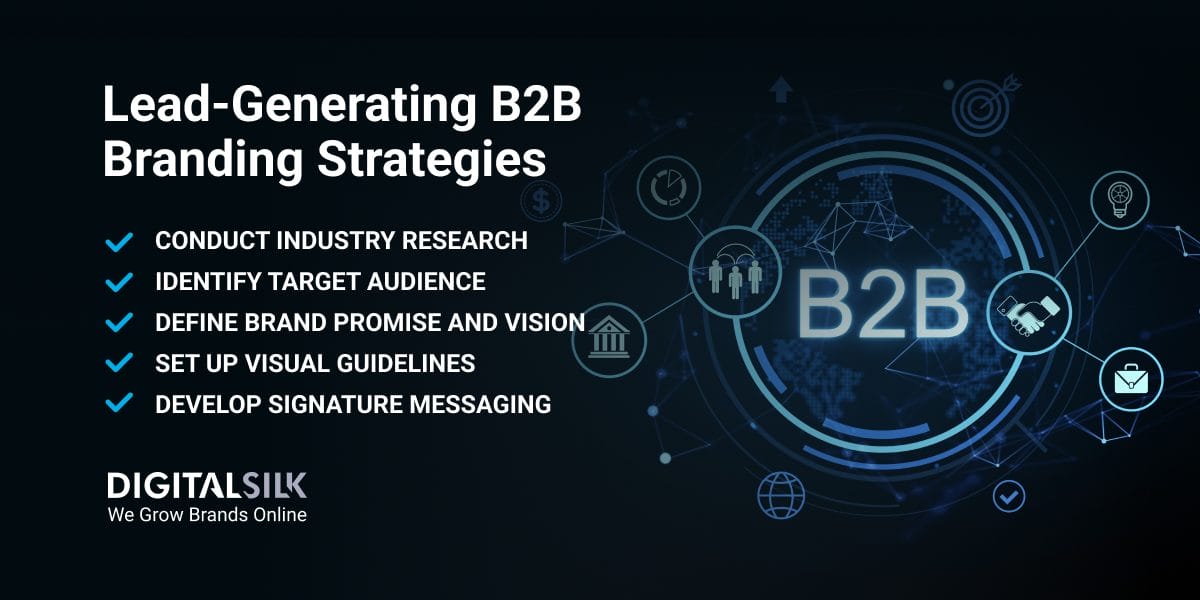Brand Repositioning: Key Highlights
-
Refine, not replace: Build on existing equity by sharpening associations instead of starting from scratch.
-
Relevance is a moving target: Adjust positioning based on what customers value now or risk fading from consideration.
-
Consistency that evolves: Keep one narrative across every touchpoint while updating voice and emphasis to reflect the new direction.
Markets shift faster than many companies realize and brands that hesitate to adapt often see their relevance slip away.
With 86% of U.S. consumers saying a brand’s reputation shapes their purchase decisions, positioning is less about short-term visibility and more about the long-term meaning a company holds in its space.
The real question is whether your brand reflects what customers value now or if it’s anchored to perceptions that no longer serve your target audience.
This article breaks down what senior executives need to know about brand repositioning, from strategies and case studies to challenges and signals, to help you evaluate when to act, how to minimize risk and how to position your brand for long-term market leadership.
7 Brand Repositioning Strategies To Consider (With Case Studies)
The brand repositioning definition is simple: it’s the process of shifting how the market perceives your company, so it feels more relevant and appealing to current expectations.
Rather than discarding your identity, it involves refining aspects such as associations, messaging, personality and overall position to better reflect what customers value.
The following strategies show different ways organizations can approach this shift to remain competitive and aligned with changing demands:
1. Assessing And Redefining Your Positioning Statement
Repositioning begins with understanding how the brand is seen today compared to how you want it to be seen tomorrow.
That requires a clear look at customer perceptions, competitive benchmarks and the factors shaping future demand.
While 87% of executives see brand-building as a top priority, that ambition means little without defining what the brand should represent and the outcomes it is meant to drive.
Questions worth addressing at this stage include:
- Which associations and qualities do customers already connect with our brand and which do we want them to?
- Where are competitors raising expectations and how do we respond without losing what makes us distinctive?
- How closely does the customer experience align with the narrative we believe we are telling?
- Are we pursuing the audiences that represent future growth or are we anchored to yesterday’s market?
- Which aspects of our identity and communications reinforce the position we want and which are working against us?
- If the perception gap is too wide, would introducing a new brand be a more effective path forward?
The outcome of this analysis is a baseline that highlights whether the brand is positioned to capture new opportunities or held back by outdated perceptions.
It also clarifies where to direct resources so that repositioning efforts create meaningful traction rather than cosmetic change.
2. Evolving Brand Messaging
Consistency builds trust, but repetition without adaptation makes a brand feel dated.
Since 92% of consumers say a consistent experience is their favorite type of brand messaging, the challenge is to maintain that familiarity while evolving the message in ways that reflect new positioning.
This approach preserves recognition and equity while introducing signals of progress customers can connect with.
Some ways to evolve and refine your messaging include:
- Reframe the narrative to emphasize differentiators that matter most to current audiences
- Adjust the voice and language so they reflect the brand’s updated personality without losing familiarity
- Audit every touchpoint, from digital platforms to retail and service interactions, to ensure consistency across channels
- Highlight new strengths or capabilities while keeping core attributes that already build trust
- Introduce updates in phases so customers can link the brand they know with the direction it’s moving in
BMW is one of the best examples of repositioning a brand since it has consistently reinforced its “Ultimate Driving Machine” ethos across advertising, dealerships and customer experiences.
Over time, it has evolved its messaging to highlight electric vehicles, technology and innovation, while preserving its strong associations with performance and prestige.
3. Targeting A New Customer Segment
Targeting a new customer segment is a defining move in enterprise brand repositioning and it often involves reengaging audiences that no longer see the brand as relevant.
78% of audiences aged 18-26 say that brands fail to engage with them due to a lack of relevance, which means the majority are making decisions without the insight needed to connect with the people they want to reach.
The real work lies in understanding why existing groups disengaged, where new demand is forming, and how to frame the brand’s value so it resonates with both.
Some strategic targeting approaches to consider include:
- Identify segments that once engaged but have shifted to competitors, and examine the reasons behind the shift
- Map the pain points and aspirations of new audiences to find alignment with the brand’s strengths
- Choose whether transparency, exclusivity or reframed value will build credibility most effectively
- Adapt offerings and communications to attract new or returning customers without undermining loyalty among existing ones
- Test small-scale campaigns or experiences to validate the fit before expanding the approach
One of the most recent brand repositioning examples in 2025 is Gucci, which under new creative leadership is seeking to recalibrate its heritage for a generation skeptical of traditional luxury.
By redefining how it engages younger audiences while protecting its legacy, Gucci illustrates how targeting new segments requires both reengagement and expansion.
4. Modernizing Your Visual Brand Identity
Visual identity shapes perception long before customers engage with your messaging.
Colors, typography and imagery instantly influence whether a brand feels relevant, with 55% of first impressions coming directly from these visual cues.
Modernizing isn’t about discarding what people already recognize.
It’s about taking the same building blocks and updating them so they reflect where the brand is headed while keeping the foundation familiar.
Continuity maintains trust, while thoughtful adjustments show the brand is evolving with intent.
You can approach modernization in your brand repositioning strategy by:
- Refresh color palettes to align with modern aesthetics while keeping core tones that drive recognition
- Simplify typography so it works seamlessly across digital formats without losing character
- Direct imagery to reflect the updated brand values while keeping familiar visual cues
- Update iconography, patterns and supporting graphics to feel current while staying consistent with the system
- Design layouts for mobile and interactive environments so the identity holds together across every channel
KIA is an example of brand repositioning that relied on visual identity to signal change.
By introducing a streamlined, futuristic logo and tying it to its shift toward electric mobility, the manufacturer moved perception from a value-driven automaker to a brand associated with innovation.
The update kept recognition intact while reframing how the company competes in a rapidly changing market.
5. Repositioning Through Emotional Storytelling
Brands compete on features, price and performance every day, yet what often decides loyalty is something harder to quantify: emotional connection.
76% of consumers say they would rather buy from a company they feel connected to than from a competitor, which shows that repositioning depends less on functional claims and more on stories that spark recognition, trust and belonging.
The most effective stories go beyond promotion by expressing purpose, values and relevance in ways customers can see themselves reflected in.
To use emotional storytelling effectively:
- Define the brand’s purpose in a way that speaks to human aspirations, not product features
- Highlight authentic stories from customers, employees or communities that reinforce the brand’s values
- Create consistency across channels so the same narrative unfolds in advertising, social and direct interactions
- Use moments of vulnerability or transparency to build credibility and trust
- Connect storytelling to real actions to ensure the brand delivers experiences that match its words
Always is one of the most successful brand repositioning examples for the way it shifted from a functional hygiene product to a symbol of empowerment.
With its Like a Girl campaign, the brand challenged stereotypes and reframed a common insult into a message of strength and confidence.
This emotional storytelling built deeper relevance with younger audiences and positioned Always as an advocate for progress, not just a product.
6. Adjusting Your Pricing Strategy
Customers interpret pricing as a signal of what the brand represents, whether it stands for broad accessibility, premium exclusivity or forward-thinking innovation.
With 68% of consumers becoming more price-conscious, the challenge lies in setting prices that protect margins while also reinforcing the story the brand wants the market to believe.
When adjusting strategy, the first step is deciding whether the goal is to capture scale or to premiumize and expand margins.
Both approaches require anticipating how existing customers will respond and how new audiences will interpret the shift.
Some brands turn to flexible models like subscriptions or bundled services that reduce friction while maintaining stature.
Others frame premium pricing in a way that highlights quality, scarcity or innovation.
Some of the key considerations at this stage include:
- How current pricing supports or undermines the positioning you want to achieve
- Whether your cost structure allows for repositioning without eroding profitability
- How flexible models such as subscriptions can broaden reach while protecting brand equity
- When higher pricing strengthens the perception of value rather than creating barriers
- How existing customers will interpret the shift and whether they feel included in the journey
Dollar Shave Club stands out in brand repositioning examples because it challenged the dominance of legacy razor brands that had relied on high prices and complex product lines.
The company introduced a subscription model that emphasized simplicity, affordability and convenience, shifting consumer perception toward a brand that felt modern and on the customer’s side.
Its pricing strategy turned razors into a service and positioned the company as a challenger that redefined value in the category.
7. Monitor And Adapt To Market Response
Repositioning doesn’t end when the new strategy goes live. Markets take time to adjust and customers often hold on to old perceptions long after a brand thinks they’ve moved on.
Real progress comes from watching how the market responds, spotting gaps between intention and reality and refining before those gaps turn into setbacks.
What to focus on to keep repositioning on track:
- Track perception and sentiment shifts regularly to confirm the brand is moving toward the identity you set out to build
- Gather feedback across touchpoints to understand how customers describe their experience in their own words
- Watch for misalignment between internal teams and external messaging since repositioning won’t hold if employees aren’t living the brand story
- Analyze every touchpoint to see if the brand promise is consistently delivered, from retail to digital to service interactions
- Approach adaptation as continuous fine-tuning, where frequent adjustments build long-term credibility
Rebranding Vs. Repositioning: Key Differences
Deciding between rebranding and repositioning often determines whether a company makes cosmetic changes or reshapes its market relevance.
Rebranding alters external identity through new visuals, names or design systems, while repositioning changes how customers interpret value, purpose and competitive standing.
Understanding the distinction clarifies whether the challenge is surface-level presentation or a deeper strategic reset:
- Focus on appearance: Rebranding changes external identity through elements like the logo, colors, packaging, or even the company name. It refreshes how the brand is presented without necessarily altering what it stands for.
- Focus on perception and value: Repositioning shifts how customers interpret the brand’s promise, associations, and role in the market. It’s less about the visuals and more about redefining relevance, meaning and competitive edge.
- Scope of change: Rebranding is primarily cosmetic, designed to modernize presentation or address confusion around identity. Repositioning reaches deeper, influencing messaging, product strategy, pricing and customer segments.
- Time horizon: Rebranding generates quick visibility by signaling a new look or identity. Repositioning takes longer because it requires changing how customers think and feel about the brand.
- Risk profile: Rebranding carries moderate risk if execution is consistent. Repositioning is higher risk because it challenges established perceptions, but it also offers the potential for long-term growth and renewed loyalty.
Here’s a brief overview of the key differences between repositioning and rebranding:
| FEATURE | REBRANDING | REPOSITIONING |
| Focus | Updates external identity such as logo, colors, packaging, or even the brand name | Redefines how customers interpret value, promise and competitive role |
| Scope | Primarily cosmetic, centered on visuals and presentation | Strategic, affecting messaging, products, pricing and target segments |
| Objective | Refresh identity or resolve confusion about how the brand is represented | Align the brand with new expectations, audiences, or market conditions |
| Impact timeline | Creates immediate visibility and signals change quickly | Requires more time as perceptions and associations evolve |
| Risk | Lower risk when execution is consistent across channels | Higher risk as it challenges existing perceptions but can unlock greater long-term gains |
Pro tip: Choose rebranding when your identity no longer reflects who you are or creates confusion.
Choose repositioning when the bigger challenge is relevance, differentiation or market alignment and the goal is to reshape meaning, not just appearance.
What Are The 9 Positioning Strategies In Marketing?
Understanding what brand repositioning is gives you context but knowing the types of strategies and when to use them is what makes the difference.
A brand can fall out of sync with the market for many reasons, from perception issues to changing customer expectations to ambitious moves into new categories.
The following approaches highlight the most common ways companies reposition and the situations that signal it may be time to act:
- Image repositioning: Alters how the brand is perceived without changing the product, often through updated messaging, refreshed identity or new associations that make the brand feel more relevant.
- Product repositioning: Updates the product or service for the same audience, such as improving quality, adding features or adapting functionality to match evolving expectations.
- Brand relaunch: Revives a brand that has lost traction or feels outdated, creating fresh attention through new messaging and visuals that reintroduce the company to the market.
- Brand extension: Expands reach by offering new products or services under the same name, maintaining relevance with current customers while opening opportunities with new ones.
- Intangible repositioning: Keeps the product the same but shifts focus to a new target audience, often aiming at segments with greater growth potential.
- Tangible repositioning: Changes both the product and the target audience, a higher-risk approach that redefines the brand’s role but can unlock new opportunities.
- Brand rejuvenation: Brings new life to existing offerings by improving speed, quality or convenience, helping retain current customers while attracting new leads who expect high-end performance.
- Brand acquisition: Expands reach by acquiring companies that already operate in the markets or categories you want to enter, offering faster repositioning than building from scratch.
- Brand partnerships: Strengthens perception and reach through collaboration with other brands, creating new associations and credibility that accelerate repositioning.
Digital Silk’s Brand Repositioning Case Studies
As a professional brand repositioning agency, Digital Silk partners with companies across industries and backgrounds to redefine how their brands compete and connect.
Our case studies highlight how strategic repositioning clarifies identity, strengthens relevance and drives long-term impact:
1. OPTO By KPI Solutions
Digital Silk partnered with KPI Solutions to reposition its logistics division with a stronger market presence.

Through a strategic rename to OPTO, paired with a bold new logo and a conceptual mood board, the brand signaled a clear move toward innovation in warehouse operations.
This transformation improved positioning, reinforced modern relevance and allowed OPTO to stand out in an increasingly competitive logistics space.
2. Capixa
Digital Silk developed Capixa’s brand identity to balance authority with approachability in the fintech space.

A distinctive name, signature typography and a streamlined color system created a brand identity that signals reliability while remaining approachable.
Clear, transparent messaging reinforced that foundation, establishing Capixa as a trustworthy partner and positioning it for long-term relevance in the fintech space.
Signs You Need A Brand Repositioning Strategy
Every brand reaches a point where what once worked starts to lose traction.
Maybe customers have shifted priorities, competitors have reset expectations or the story your brand tells no longer matches the experience you deliver.
Recognizing the signs early gives you a chance to reposition from a place of strength rather than waiting until decline forces your hand:
1. Declining Sales Or Stagnant Market Share
If growth has stalled despite ongoing campaigns or product updates, the issue often lies in how the brand is positioned rather than in execution. Repositioning can reconnect perception with market demand.
2. Difficulty Outperforming Competitors
When customers see little difference between you and others in the category, price becomes the deciding factor.
Since 93% of consumers say they would choose better value for money, you should redefine what makes your brand worth choosing, whether that’s superior quality, a stronger experience or a distinct point of view that competitors cannot replicate.
3. Shifts In Customer Expectations
Audiences evolve quickly and what resonated a few years ago may no longer matter.
If your brand feels out of step with current priorities, relevance erodes faster than revenue reports show.
4. Outdated Or Mismatched Perception
When the market’s perception of your brand lags behind the reality of your offerings, trust weakens. The gap between what you deliver and what people believe becomes a liability.
5. Entering New Categories Or Markets
Growth creates opportunity but also confusion if the brand story doesn’t evolve.
Expanding into new areas demands a narrative that ties the move to a larger sense of purpose.
Common Challenges In A Brand Repositioning Strategy
The repositioning of a brand requires significant investment in research, design and execution, yet the real risk comes from how quickly customers can disengage when the shift feels misaligned.
A single misstep can weaken equity built over years, create openings for competitors and leave once-loyal customers questioning whether the brand still reflects them.
Some of the key brand repositioning challenges to keep an eye on include:
- Misaligning with audience expectations: When the new direction fails to reflect what customers value, perception changes in ways that diminish relevance. This often stems from ignoring cultural context, emotional ties, or shifts in customer behavior.
- Disjointed or inconsistent rollout: Execution that varies across packaging, campaigns, and service interactions creates confusion. Customers notice the disconnect quickly and credibility erodes with every inconsistency.
- Losing connection to core brand identity: Removing or altering the elements that anchor recognition and trust risks alienating loyal customers. Equity that took years to build can collapse if the new positioning feels disconnected from the brand’s history.
- No distinct value proposition: Without a differentiated promise, a repositioned brand blends into the broader market. Competitors that present clearer value step in to capture attention and loyalty.
- Market misread or poor timing: Launching during unfavorable conditions or ignoring market dynamics undermines adoption. Even well-developed strategies struggle when customer priorities shift or when economic realities make the new positioning feel out of reach.
- Issues with customer loyalty: When loyal customers no longer see themselves in the brand, defections accelerate. Replacing them demands far greater investment than sustaining trust and often damages reputation in the process.
- Negative impact on revenue or brand equity: Failed repositioning weakens both immediate sales and long-term value. Recovery requires heavy reinvestment and often takes years, with no guarantee of restoring the original equity.
Reposition Your Brand Strategically With Digital Silk
Repositioning a brand requires a thoughtful approach that connects audience expectations with market realities while protecting the equity already in place.
Companies that treat it as a continuous process of refining strategy and execution are the ones that strengthen connections and remain relevant as markets evolve.
Digital Silk ranks among the top companies for brand refresh and repositioning, guiding brands through strategies that strengthen perception, improve differentiation and unlock new opportunities for growth.
As a full-service branding agency, our experts offer:
- Branding solutions
- Brand positioning
- Brand identity development
- Logo and brand design
- Rebranding services
- Custom web design
- Digital marketing
Our experts take charge of the entire process, delivering measurable performance supported by clear, consistent communication.
Contact our team, call us at (800) 206-9413 or fill in the Request a Quote form below to schedule a consultation.
"*" indicates required fields









